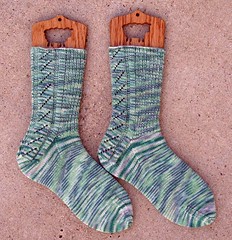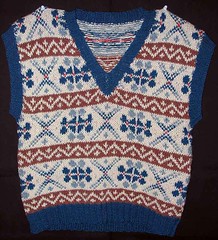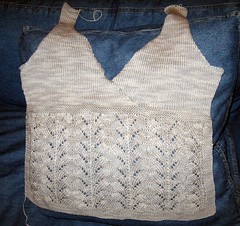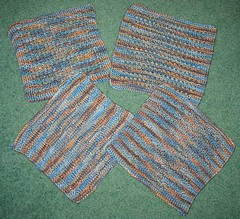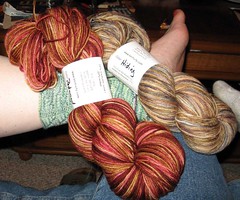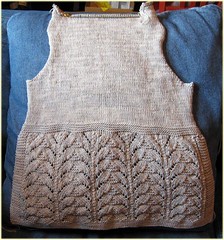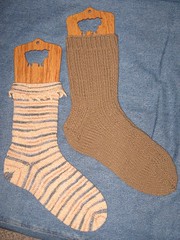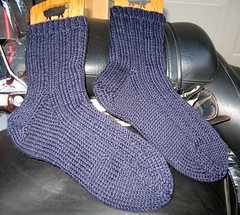Welcome to the next in my series of posts on teaching beginning knitting. Previous posts are in the sidebar, or you can find them by searching for "teaching ideas." Eventually, I'll put them all together.
Now we are finally into teaching new knitters how to DO something! Here are my tips for teaching the knitted cast on. Your mileage may vary,
yadda yadda.
But Wait!Before we get moving set some expectations. Ask how many in the class learned to knit years ago but think they have forgotten. Ask how many know how to crochet. Ask how many are between the ages of 12 and 17. Tell the class not to be surprised if these students seem to pick things up more quickly and not to be discouraged by that. Many times the knitting skill comes right back to people who think they have forgotten how. Crocheters are used to manipulating needles and yarn, so they often pick up knitting quickly. And for some reason, the teenage brain is hard-wired for knitting acquisition and many teens just take off with very little instruction (I have had to slow some down, because they start going so fast they get sloppy).
Gently remind people with known issues (tremors, bad arthritis, brain injuries, known small motor skill issues) that they might take longer to get the hang of knitting. But, that is just fine. Knitting is not a race. It is a life-long avocation, so it is not really important how long it takes to learn--it's just great to learn. And knitting is often great therapy if you do have an issue with your hands or coordination.
I usually point out cheerfully that I have never failed to get someone knitting, which is the truth. (I do think there may be one or two who didn't keep it up, but they did at least make some stitches.)
Demo Equipment
A word about the equipment you use to teach. I like to use size 19 needles (I use Bryspun because they have some "grip") and super bulky yarn. We have used the same ball of pink "Big Baby" Acrylic for over a year at the yarn shop, and it's taught both knitting and crochet! I also use it as an example of how some acrylic doesn't feel all that pleasant to the touch.
OK, Now the Slip KnotFirst ya gotta do a slip knot. I am always surprised at how few people know how to do this. I find it easiest in a group setting to teach this like you would for a small child.
1. Lay your yarn on the table and make a loop with the free end on top. Have just a few inches of yarn before the
loop.
2. Take the yarn end that is attached to the skein or ball and push a loop of it through the loop on the table.
3. Grasp what you pushed through in one hand and the free end in the other hand and gently pull.
4. You will have a knot that will slide up and down the end attached to the skein.
5. Place this loop on a knitting needle and gently tighten.
Here is where I then explain how you want the loop to be loose enough to slide up and down the needle easily, but tight enough that you don't see a lot of "daylight" around the loop. I sat that is the tension you will aim for in all your knitting.
Notes on the Cast-OnNext you will show the students how to cast on. I usually don't tell them it is called the knitted cast-on at first--I let that be a happy surprise when they later realize they already know most of the steps to knitting. I point out that all knitting consists of is loops building upon loops. In order to start, you need more than that one pitiful slip knot as loops. That's why you cast on--you need that first set of loops.
1. First I slowly demonstrate a cast on stitch. I position myself where everyone can see my hands and the yarn. I ask them to set their needles down and watch, because I've found that if they hold their needles, they try to follow along, which of course means they look at their needles, not mine, and miss something. I let them follow on the second or third demo.
2. I stick the right needle in the slip knot and say remember this direction. You are poking it UP and sticking the new needle BEHIND the one with the knot. You will do this over and over.
3. When I wrap, I point out the yarn is going left to right, and that I try to "snug" the yarn between the two needles, because that makes the next step easier.
4. I admit that poking the yarn through the loop already on the needle is the biggest challenge. I tell them that they need to feel free to use their fingers to move the needles and hold the yarn in place. I demo that my index finger helps me move the right needle into position to move the yarn through the loop. I also reassure them there is more than one way to accomplish this maneuver, and that their fingers are more than welcome to help at first.
5. I tell them to pull the new loop toward their chest, to make a nice big loop to put back on the right needle. (If they ask if they should twist it or not, tell them it works either way, just be consistent.) Then I say later they won't need to pull so much yarn out. I stress that when you put the new loop on the right needle, you need to "snug" it, not "tighten" it, because you want to make it easy to get the needle back in for the next stitch.
As I demonstrate, I make sure to show them each step clearly as well as to articulate it, giving whatever mnemonics seem to help. This addresses people who learn best by seeing and those who learn best by hearing. I address the people who learn by doing in step 6. That hits most of the standard learning styles, giving everyone a chance. I also have the information written down in handouts, for people who like to read instructions.
Hint: a question that usually comes up is, "Why is the last loop I put on sideways? It looks different!" You can
explain that in this cast on, the newest loop always slants, but straightens right up when you put a new loop on. It's normal.
6. After showing them a couple of times, I look around at the panicked expressions and say I will now help each of them get started. Then they look relieved. Those who "get it" are encouraged to go ahead and put X number of stitches on, or to help their neighbor--I explain that one really good way to learn something well is to teach someone else. Then I go around the group. I try to start with the most frightened looking student. I figure if they get going, everyone else will feel better. I usually only have to help for 3-4 stitches and they get it. If not, I move on and come back.
Hint: You will have people who don't care what their cast-on stitches look like, and others who get upset if they have a slightly bigger loop in one spot or another. For the second bunch, encourage them to start again as many times as they like. They'll remember better later. For the others, if they decide their cast on looks icky after they've knitted a few rows,
extol the virtues of fringe on a scarf. It hides that.
OK, until I think of something I have missed, that's it for teaching the cast on. Next: we let them knit something.

